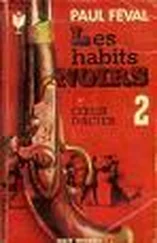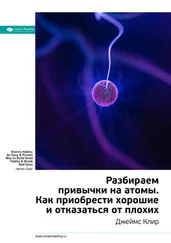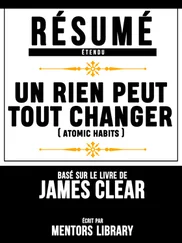We can split these four steps into two phases: the problem phase and the solution phase. The problem phase includes the cue and the craving, and it is when you realize that something needs to change. The solution phase includes the response and the reward, and it is when you take action and achieve the change you desire.
Problem phase
1. Cue
2. Craving
Solution phase
3. Response
4. Reward
All behavior is driven by the desire to solve a problem. Sometimes the problem is that you notice something good and you want to obtain it. Sometimes the problem is that you are experiencing pain and you want to relieve it. Either way, the purpose of every habit is to solve the problems you face.
In the table on the following page, you can see a few examples of what this looks like in real life.
Imagine walking into a dark room and flipping on the light switch. You have performed this simple habit so many times that it occurs without thinking. You proceed through all four stages in the fraction of a second. The urge to act strikes you without thinking.
Problem phase
1. Cue:Your phone buzzes with a new text message.
2. Craving:You want to learn the contents of the message.
Solution phase
3. Response:You grab your phone and read the text.
4. Reward:You satisfy your craving to read the message. Grabbing your phone becomes associated with your phone buzzing.
Problem phase
1. Cue:You are answering emails.
2. Craving:You begin to feel stressed and overwhelmed by work. You want to feel in control.
Solution phase
3. Response:You bite your nails.
4. Reward:You satisfy your craving to reduce stress. Biting your nails becomes associated with answering email.
Problem phase
1. Cue:You wake up.
2. Craving:You want to feel alert.
Solution phase
3. Response:You drink a cup of coffee.
4. Reward:You satisfy your craving to feel alert. Drinking coffee becomes associated with waking up.
Problem phase
1. Cue:You smell a doughnut shop as you walk down the street near your office.
2. Craving:You begin to crave a doughnut.
Solution phase
3. Response:You buy a doughnut and eat it.
4. Reward:You satisfy your craving to eat a doughnut. Buying a doughnut becomes associated with walking down the street near your office.
Problem phase
1. Cue:You hit a stumbling block on a project at work.
2. Craving:You feel stuck and want to relieve your frustration.
Solution phase
3. Response:You pull out your phone and check social media.
4. Reward:You satisfy your craving to feel relieved. Checking social media becomes associated with feeling stalled at work.
Problem phase
1. Cue:You walk into a dark room.
2. Craving:You want to be able to see.
Solution phase
3. Response:You flip the light switch.
4. Reward:You satisfy your craving to see. Turning on the light switch becomes associated with being in a dark room.
By the time we become adults, we rarely notice the habits that are running our lives. Most of us never give a second thought to the fact that we tie the same shoe first each morning, or unplug the toaster after each use, or always change into comfortable clothes after getting home from work. After decades of mental programming, we automatically slip into these patterns of thinking and acting.
THE FOUR LAWS OF BEHAVIOR CHANGE
In the following chapters, we will see time and again how the four stages of cue, craving, response, and reward influence nearly everything we do each day. But before we do that, we need to transform these four steps into a practical framework that we can use to design good habits and eliminate bad ones.
I refer to this framework as the Four Laws of Behavior Change , and it provides a simple set of rules for creating good habits and breaking bad ones. You can think of each law as a lever that influences human behavior. When the levers are in the right positions, creating good habits is effortless. When they are in the wrong positions, it is nearly impossible.
How to Create a Good Habit
The 1st law (Cue):Make it obvious.
The 2nd law (Craving):Make it attractive.
The 3rd law (Response):Make it easy.
The 4th law (Reward):Make it satisfying.
We can invert these laws to learn how to break a bad habit.
How to Break a Bad Habit
Inversion of the 1st law (Cue):Make it invisible.
Inversion of the 2nd law (Craving):Make it unattractive.
Inversion of the 3rd law (Response):Make it difficult.
Inversion of the 4th law (Reward):Make it unsatisfying.
It would be irresponsible for me to claim that these four laws are an exhaustive framework for changing any human behavior, but I think they’re close. As you will soon see, the Four Laws of Behavior Change apply to nearly every field, from sports to politics, art to medicine, comedy to management. These laws can be used no matter what challenge you are facing. There is no need for completely different strategies for each habit.
Whenever you want to change your behavior, you can simply ask yourself:
How can I make it obvious?
How can I make it attractive?
How can I make it easy?
How can I make it satisfying?
If you have ever wondered, “Why don’t I do what I say I’m going to do? Why don’t I lose the weight or stop smoking or save for retirement or start that side business? Why do I say something is important but never seem to make time for it?” The answers to those questions can be found somewhere in these four laws. The key to creating good habits and breaking bad ones is to understand these fundamental laws and how to alter them to your specifications. Every goal is doomed to fail if it goes against the grain of human nature.
Your habits are shaped by the systems in your life. In the chapters that follow, we will discuss these laws one by one and show how you can use them to create a system in which good habits emerge naturally and bad habits wither away.
Chapter Summary
A habit is a behavior that has been repeated enough times to become automatic.
The ultimate purpose of habits is to solve the problems of life with as little energy and effort as possible.
Any habit can be broken down into a feedback loop that involves four steps: cue, craving, response, and reward.
The Four Laws of Behavior Change are a simple set of rules we can use to build better habits. They are (1) make it obvious, (2) make it attractive, (3) make it easy, and (4) make it satisfying.
THE 1ST LAWMake It Obvious
4 The Man Who Didn’t Look Right
THE PSYCHOLOGIST GARY Klein once told me a story about a woman who attended a family gathering. She had spent years working as a paramedic and, upon arriving at the event, took one look at her father-in-law and got very concerned.
“I don’t like the way you look,” she said.
Читать дальше




![Джеймс Клир - Атомные привычки [Как приобрести хорошие привычки и избавиться от плохих]](/books/403243/dzhejms-klir-atomnye-privychki-kak-priobresti-horosh-thumb.webp)



